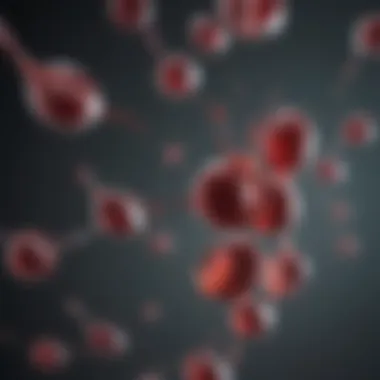Sickle Cell Anemia and Chemotherapy: A Comprehensive Analysis


Intro
Sickle cell anemia is a hereditary disorder characterized by the presence of abnormal hemoglobin, known as hemoglobin S. This condition leads to the distortion of red blood cells into a sickle shape, which results in various health complications. These complications include chronic pain episodes, increased infection risk, and potential organ damage. The management of sickle cell anemia involves multiple treatment strategies aimed at alleviating symptoms and preventing acute complications.
Chemotherapy is often associated with cancer treatment but has emerged as a consideration in managing sickle cell anemia. This article investigates the interplay between sickle cell anemia and chemotherapy, addressing its implications for treatment and patient care. A deep dive into existing and emerging strategies will reveal the nuances of using chemotherapy as a therapeutic option. Understanding these relationships is crucial for healthcare providers and patients alike.
This exploration will unfold as we delineate key concepts, current research trends, and potential future directions in treatment strategies that prioritize patient outcomes.
Preamble to Sickle Cell Anemia
Sickle cell anemia is a significant genetic disorder that affects millions of people worldwide. Understanding this condition is crucial for several reasons. It not only informs those affected about their health but also guides practitioners in managing their care effectively. This introduction will explore sickle cell anemia's impact on individuals and communities, emphasizing the necessity of comprehensive treatment approaches, including chemotherapy.
Understanding Sickle Cell Anemia
Sickle cell anemia is characterized by the production of abnormal hemoglobin, known as hemoglobin S. This genetic mutation causes red blood cells to take a sickle shape, especially when oxygen levels are low. These misshapen cells lead to various complications, including pain, organ damage, and increased risk of infection. Patients often experience recurrent pain episodes, known as crises, due to the blockage of blood flow in small vessels. These issues highlight the importance of understanding sickle cell anemia, as knowledge can lead to better support and management strategies for those living with the disease.
Genetic Basis of the Disease
The genetic foundation of sickle cell anemia stems from a mutation in the HBB gene found on chromosome 11. This mutation alters the structure of hemoglobin. Individuals inheriting two copies of the mutated gene typically develop sickle cell anemia, while those with one mutated gene are carriers but do not usually exhibit symptoms. Genetic counseling plays a vital role for families affected by this disorder, as insights into inheritance patterns can guide decisions regarding family planning.
Epidemiology and Demographics
Sickle cell anemia predominantly affects individuals of African, Mediterranean, Middle Eastern, and Indian descent. In some regions, particularly Sub-Saharan Africa, the prevalence is notably high. The World Health Organization estimates that around 300,000 infants are born with the disease each year. This demographic data is essential for understanding the global burden of the disease and developing targeted public health initiatives. Healthcare systems must recognize these patterns to allocate resources efficiently and provide suitable care.
Clinical Features of Sickle Cell Anemia
Understanding the clinical features of sickle cell anemia is crucial for both diagnosis and management of the disease. The clinical manifestations give insights into the pathophysiology, complications, and overall impact on patient quality of life. Recognizing symptoms helps healthcare providers to intervene early and adequately. This section explores symptoms and complications associated with the disease, and outlines the diagnostic approaches commonly utilized.
Symptoms and Complications
Sickle cell anemia presents with a range of symptoms that vary widely among individuals. Common symptoms include:
- Fatigue: Many patients experience chronic tiredness, often due to anemia.
- Pain Crises: Known as sickle cell crises, these episodes occur when sickled cells block blood flow in small vessels, causing intense pain.
- Swelling: Swelling in hands and feet can occur due to vaso-occlusive events.
- Frequent Infections: The spleen’s function is compromised, leading to a higher risk of infections.
- Delayed Growth: Children with sickle cell anemia may grow slower than their peers due to chronic health issues.
- Vision Problems: Damage to blood vessels in the eyes can lead to visual impairments.
Complications from sickle cell anemia can be severe and include:
- Acute Chest Syndrome: A life-threatening condition that resembles pneumonia, arising from blocked blood vessels in the lungs.
- Stroke: Blockages can disrupt blood flow to the brain.
- Organ Damage: Failure of organs such as the kidneys and liver can occur over time.
- Leg Ulcers: These can develop as a result of poor blood flow to the extremities.
Symptoms can vary in severity, and patients often face challenges in daily life. Effective management of these symptoms is essential for improving the quality of life.
Diagnostic Approaches
Accurate diagnosis of sickle cell anemia relies on specific tests that confirm the presence of the sickle hemoglobin variant. Common diagnostic methods include:
- Blood Tests: A complete blood count can indicate anemia levels. Hemoglobin electrophoresis identifies different types of hemoglobin in the blood.
- Newborn Screening: Routine tests for newborns can identify sickle cell anemia early, allowing for prompt intervention.
- Family History Assessment: Understanding the genetic background can support diagnosis, particularly in regions where sickle cell disease is more prevalent.
Early diagnosis is significant for managing the disease proactively. It helps in planning treatment strategies and also assists in educating families about the disorder.


"Prompt diagnosis and comprehensive management are essential for mitigating the complications associated with sickle cell anemia."
"Prompt diagnosis and comprehensive management are essential for mitigating the complications associated with sickle cell anemia."
In summary, recognizing the clinical features of sickle cell anemia, including symptoms, complications, and diagnostic methods is vital. This comprehension allows healthcare providers to develop tailored treatment plans that enhance patient outcomes.
Current Treatment Strategies for Sickle Cell Anemia
The management of sickle cell anemia involves various treatment strategies that aim to alleviate symptoms, reduce complications, and improve patients' overall quality of life. Understanding these options is crucial, as they provide insights into how clinicians can tailor therapy to individual needs. The current strategies focus on medicinal interventions, transfusion methods, and holistic approaches. Each has its own importance and effectiveness, contributing to a multifaceted treatment plan.
Hydroxyurea Therapy
Hydroxyurea is a cornerstone in the treatment of sickle cell anemia. This medication works by increasing fetal hemoglobin levels, which can inhibit the sickling of red blood cells. Higher fetal hemoglobin levels lead to fewer vaso-occlusive crises and reduced need for blood transfusions.
- Benefits of hydroxyurea therapy include:
- Reduced frequency of pain crises.
- Decrease in acute chest syndrome occurrences.
- Improved overall health and lifespan for patients.
However, the medication is not without risks. Potential side effects can include cytopenias and gastrointestinal issues. Regular monitoring of blood counts is essential for early identification of adverse reactions. The effectiveness of hydroxyurea is notable, but patient compliance and education about the medication are critical for optimal results.
Pain Management Techniques
Managing pain in sickle cell anemia is an essential aspect of treatment. The unpredictable nature of pain crises requires a flexible and tailored approach. Techniques often utilized include:
- Pharmacologic interventions: Nonsteroidal anti-inflammatory drugs (NSAIDs) and opioids can provide relief during acute crises. Furthermore, adjuvant therapies like gabapentin can be effective in managing chronic pain.
- Non-pharmacologic strategies: Cognitive-behavioral therapy, acupuncture, and relaxation techniques can assist in pain management. These approaches play a role in reducing psychological stress associated with chronic pain.
Effective pain management not only improves physical well-being but also enhances the quality of life for patients. It is important to remember that a multidisciplinary approach is often beneficial, integrating both medication and supportive therapies to create a well-rounded pain management plan.
Blood Transfusions and Bone Marrow Transplants
Blood transfusions are a vital part of the treatment plan for many patients with sickle cell anemia. They can prevent complications such as stroke and acute chest syndrome by supplying healthy red blood cells. Regular transfusions, however, come with risks, including iron overload and alloimmunization.
- Bone marrow transplant is another option, considered the only potential cure for sickle cell disease. It involves replacing the patient's bone marrow with that of a suitable donor, ideally a sibling or matched unrelated donor. This method can lead to a disease-free state but carries significant risks, such as graft-versus-host disease and complications from the conditioning regimen.
The Role of Chemotherapy in Managing Sickle Cell Anemia
Chemotherapy is often associated with the treatment of cancer, but its relevance extends to other conditions, including sickle cell anemia. Understanding how chemotherapy can be integrated into the management of this genetic disorder is essential. The use of chemotherapy involves a strategic approach aimed at altering the disease's progression and improving patient outcomes. By exploring the various dimensions of chemotherapy in sickle cell anemia, we can identify its potential roles, complexities, and overall significance in treatment regimens.
Chemotherapy Explained
Chemotherapy refers to the use of chemical agents to treat diseases, primarily cancer. In the context of sickle cell anemia, specific chemotherapeutic drugs, such as hydroxyurea, can promote the production of fetal hemoglobin. This increase in fetal hemoglobin levels helps reduce the sickling of red blood cells, potentially alleviating symptoms and complications associated with sickle cell disease. Different protocols may involve combinations of drugs tailored to the individual patient’s needs, considering factors like age, health status, and disease severity.
Mechanisms of Action Relevant to Sickle Cell Disease
The mechanics of how chemotherapy impacts sickle cell anemia are multifaceted. Key mechanisms include:
- Fetal Hemoglobin Induction: Chemotherapy can stimulate the production of fetal hemoglobin in the bone marrow. Increased fetal hemoglobin interferes with the polymerization of sickle hemoglobin, reducing cell sickling.
- Modification of Immune Response: Certain chemotherapeutic agents can modulate the immune system, helping to manage complications such as vaso-occlusive crises.
- Anti-inflammatory Effects: Some drugs may exert anti-inflammatory effects, which are crucial for managing recurrent pain episodes that patients often experience.


These mechanisms collectively contribute to improved hemolysis and reduction in the frequency of painful episodes.
Potential Benefits of Chemotherapy
The integration of chemotherapy into the treatment of sickle cell anemia offers several important benefits. Firstly, it has been shown to reduce the incidence of painful crises significantly. Secondly, patients often experience fewer hospitalizations, leading to improved quality of life. Clinical data suggests that when hydroxyurea is utilized in treatments, there are marked decreases in acute chest syndrome and other complications associated with sickle cell disease.
Moreover, using chemotherapy can also allow for better management of the disease over time, which may prolong patient lifespan. Ensuring that patients are closely monitored and their treatment plans are adapted as needed is crucial for maximizing these potential benefits.
Overall, incorporating chemotherapy into the treatment landscape for sickle cell anemia marks a critical advancement, providing an additional avenue to enhance traditional therapies and improve patient care.
Overall, incorporating chemotherapy into the treatment landscape for sickle cell anemia marks a critical advancement, providing an additional avenue to enhance traditional therapies and improve patient care.
Challenges and Risks Associated with Chemotherapy
The incorporation of chemotherapy in the management of sickle cell anemia presents various challenges and risks. Understanding these elements is essential for patients and healthcare providers alike. Chemotherapy can bring about significant benefits but it also poses potential hazards that must be carefully weighed. An informed approach enables the development of effective treatment plans that seeking to optimize patient outcomes.
Adverse Effects of Chemotherapy
Chemotherapy is known for its considerable side effects, which can be pronounced in patients with sickle cell anemia. Common adverse effects include nausea, vomiting, hair loss, and fatigue. These symptoms arise due to chemotherapy's mechanism, which targets rapidly dividing cells, a characteristic of both cancerous tissues and normal tissues, like those in the gastrointestinal tract and hair follicles.
Additionally, the risk of acute sickle cell crises increases with chemotherapy treatment. Patients may experience increased pain and discomfort. Anemia may also worsen, leading to complications such as infections and prolonged recovery times. The degree of these effects can vary widely, depending on the individual's overall health and the specific chemotherapy regimen used.
"The side effects associated with chemotherapy can significantly affect how patients cope with their condition and adherence to treatment plans."
"The side effects associated with chemotherapy can significantly affect how patients cope with their condition and adherence to treatment plans."
Impact on Patient Quality of Life
The effects of chemotherapy extend beyond physical health, influencing the overall quality of life for individuals with sickle cell anemia. Many patients may feel overwhelmed by the prospect of managing their condition alongside chemotherapy.
Challenges include:
- Emotional Distress: Anxiety and depression may arise due to the burdens of treatment and disease management.
- Social Isolation: Patients may avoid social activities due to physical discomfort or concerns over their appearance, such as hair loss.
- Economic Impact: Treatment for sickle cell anemia, including chemotherapy, can lead to significant financial strain, affecting both patients and families.
As these factors can compound one another, they necessitate a holistic approach to patient care. Support from healthcare providers must include not only medical management but also mental health resources and social support systems.
Emerging Therapies and Research Developments
The exploration of emerging therapies and research developments is crucial in the context of sickle cell anemia and chemotherapy. This section highlights innovative approaches that have the potential to change treatment paradigms and improve patient outcomes. As research continues to progress, understanding these emerging treatments becomes essential for students, researchers, and healthcare professionals alike.
Gene Therapy Approaches
Gene therapy represents a revolutionary advance in the treatment of genetic disorders, including sickle cell anemia. The goal of gene therapy is to correct or replace defective genes responsible for disease development. One of the most promising techniques involves the use of CRISPR technology. This method allows for precise editing of the genome, offering the potential to directly alter the faulty hemoglobin gene responsible for sickle cell anemia.
The benefits of gene therapy are significant. Patients may experience a reduction in symptoms and complications associated with sickle cell disease. Early trials have shown encouraging results, with some patients demonstrating a complete transition from sickle cell pathology to healthy red blood cells. These changes can result in fewer pain crises, decreased hospitalizations, and improved overall quality of life.
However, there are considerations to take into account. Cost is a major concern; gene therapy can be expensive, limiting access for many patients. Furthermore, long-term effects remain largely unknown, demanding rigorous follow-up studies to assess safety and efficacy over time. There is also the issue of delivery mechanisms for the gene-editing tools, which must be effective and minimize potential off-target effects.


Novel Chemotherapeutic Agents
In addition to gene therapy, novel chemotherapeutic agents are being developed specifically for the management of sickle cell anemia. These agents aim to modify disease behavior and address complications associated with the disorder. For instance, l-glutamine has shown promise as it alters metabolism of erythrocytes, helping to reduce sickling and hemolysis driven by oxidative stress.
Advancements in pharmacological tools have led to developing targeted therapies. One notable agent is voxelotor, which works by increasing hemoglobin's affinity for oxygen. This agent has shown efficacy in increasing hemoglobin levels and reducing hemolytic events, thus improving quality of life for patients.
Yet, some challenges persist. Adverse effects remain a concern, and careful monitoring is essential to ensure patient safety. Additionally, further clinical trials are required to establish these agents' long-term effectiveness and safety profiles. The precise mechanisms through which these novel therapies act must also be fully understood to optimize their use in clinical practice.
"Emerging therapies in sickle cell anemia treatment may not only offer hope but also reshape patient care approaches entirely, highlighting the importance of ongoing research."
"Emerging therapies in sickle cell anemia treatment may not only offer hope but also reshape patient care approaches entirely, highlighting the importance of ongoing research."
Ongoing Clinical Trials and Future Directions
Ongoing clinical trials represent a critical frontier in the landscape of sickle cell anemia treatment, particularly regarding chemotherapy. These trials are essential for advancing scientific knowledge, exploring therapeutic options, and determining the efficacy and safety of emerging treatments. As healthcare professionals seek to optimize care for patients with sickle cell anemia, understanding the structure and purpose of these trials is invaluable.
Currently, there are several active clinical trials focused on different aspects of treating sickle cell anemia. A variety of agents, including novel chemotherapeutic agents, are being tested in both adult and pediatric populations. The clinical trials are designed to assess various endpoints, such as pain management, reduction in complications, and overall patient quality of life. This ongoing research helps to establish robust data necessary for refining treatment protocols and determining best practices.
Moreover, these trials offer insights into how individual variations can impact treatment outcomes. For example, genetic differences among patients may influence how they respond to specific therapies. This reinforces the need for personalized treatment plans, which clinical trials can help inform.
"Clinical trials are the cornerstone of understanding how to better manage sickle cell disease, leading to groundbreaking improvements in patient care."
"Clinical trials are the cornerstone of understanding how to better manage sickle cell disease, leading to groundbreaking improvements in patient care."
Overview of Current Clinical Trials
In the realm of sickle cell anemia, numerous clinical trials are currently underway, investigating a range of treatment methodologies and their capacities to enhance patient care. Some notable trials include:
- Gene Therapy Trials: These trials focus on modifying the patient's genetic makeup to promote the production of fetal hemoglobin, which can reduce the sickling of red blood cells.
- Combination Therapies: Some studies are exploring the synergistic effects of combining traditional chemotherapy agents with newer modalities, aiming to maximize therapeutic benefits while minimizing side effects.
- Targeted Drug Approvals: Trials are examining medications specifically designed to address the unique pathophysiology of sickle cell disease and reduce complications associated with the condition.
Enrolling in a clinical trial allows patients to access cutting-edge therapies and contribute to the advancement of treatment options for future generations. For healthcare providers, these trials provide access to real-world data that can help fine-tune treatment approaches and improve outcomes.
Potential Impacts on Treatment Protocols
The potential impacts of clinical trials on treatment protocols for sickle cell anemia are substantial. First, they provide empirical evidence that can lead to the adoption of new therapies into standard practice. This is crucial in an era where medicine is increasingly driven by data and patient outcomes.
Adopting protocols based on trial findings can lead to:
- Enhanced Efficacy: New treatment combinations or innovative strategies identified in trials can significantly boost patient outcomes.
- Improved Safety Profiles: Trials often reveal adverse effects that were not previously understood, prompting adjustments in treatment plans to minimize risks.
- Increased Acceptance of Personalized Medicine: As research continues to highlight individual differences in treatment responses, protocols will evolve to incorporate personalized care.
The End
The conclusion of this article highlights the vital aspects of understanding the relationship between sickle cell anemia and chemotherapy. This interconnection is critical, especially in the realm of treatment strategies. Here, we summarize the key takeaways related to the complexities of managing sickle cell anemia with chemotherapy, specifically noting how chemotherapy can provide potential benefits amidst notable challenges.
Chemotherapy offers a potential avenue for addressing complications associated with sickle cell anemia. The analysis has revealed that while standard treatments like hydroxyurea play a significant role, the integration of chemotherapeutic agents could enhance patient outcomes. It is crucial to understand that chemotherapy is not a standalone solution but rather part of a broader approach to managing this chronic condition. Tailored therapies that consider each patient's unique genetic makeup and health profile are imperative for effective disease management.
Moreover, it’s essential to recognize the adverse effects associated with chemotherapy, which can impact quality of life. Awareness of these potential side effects is critical for patients, healthcare providers, and researchers alike. Thus, an emphasis on individual treatment plans and monitoring is necessary to balance therapeutic benefits against unwanted side effects.
Summary of Key Points
- Chemotherapy's Role: It serves as a supplementary tool in managing sickle cell anemia alongside other treatments.
- Potential Benefits: Patients may experience improved outcomes from specific chemotherapeutic agents.
- Adverse Effects: The side effects of chemotherapy must be carefully managed to maintain quality of life.
- Personalized Treatment: A one-size-fits-all approach is inadequate; treatment should be customized.
Call for Further Research
There is a pressing need for continued research into the use of chemotherapy in treating sickle cell anemia. Potential areas to explore include the development of less toxic chemotherapy regimens and the investigation of combination therapies that may yield synergistic effects. Furthermore, evaluating the long-term impacts of chemotherapy on sickle cell disease patients is necessary to better inform treatment protocols. Future studies should focus on large-scale clinical trials to provide robust data that can guide best practices in managing the disease. This will not only enhance patient care but also advance the overall scientific understanding of sickle cell anemia and its complications.







